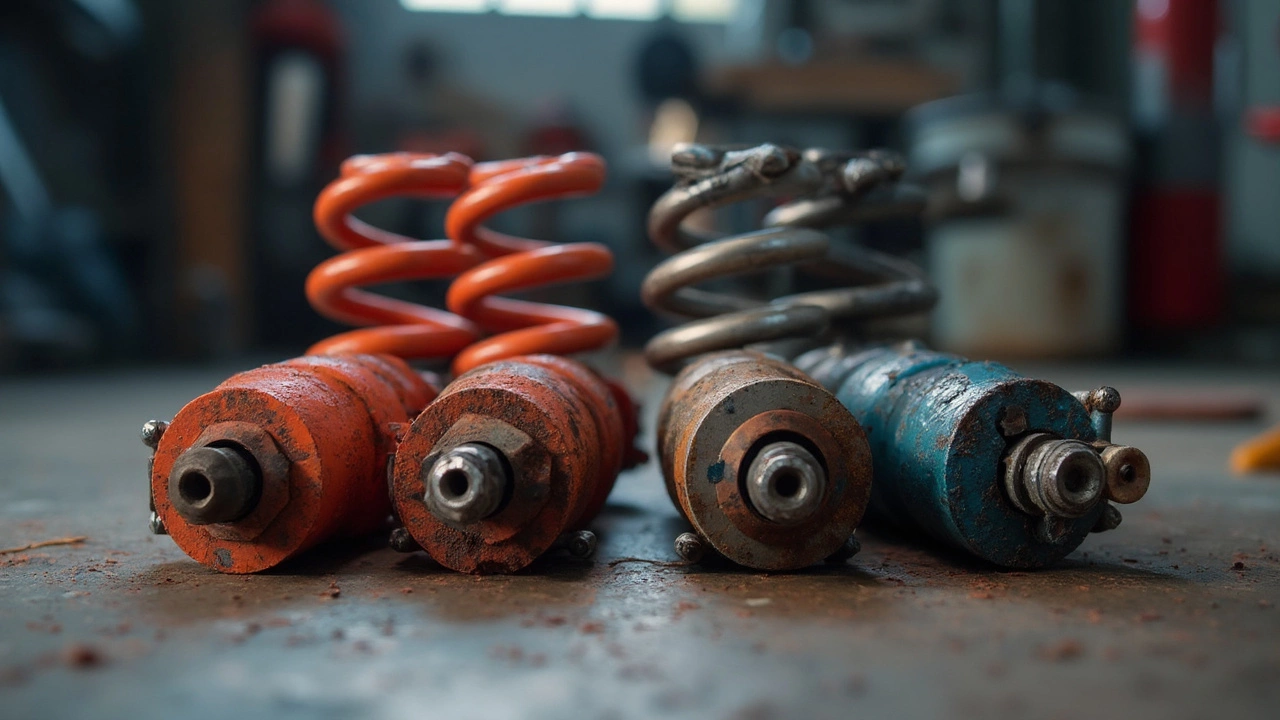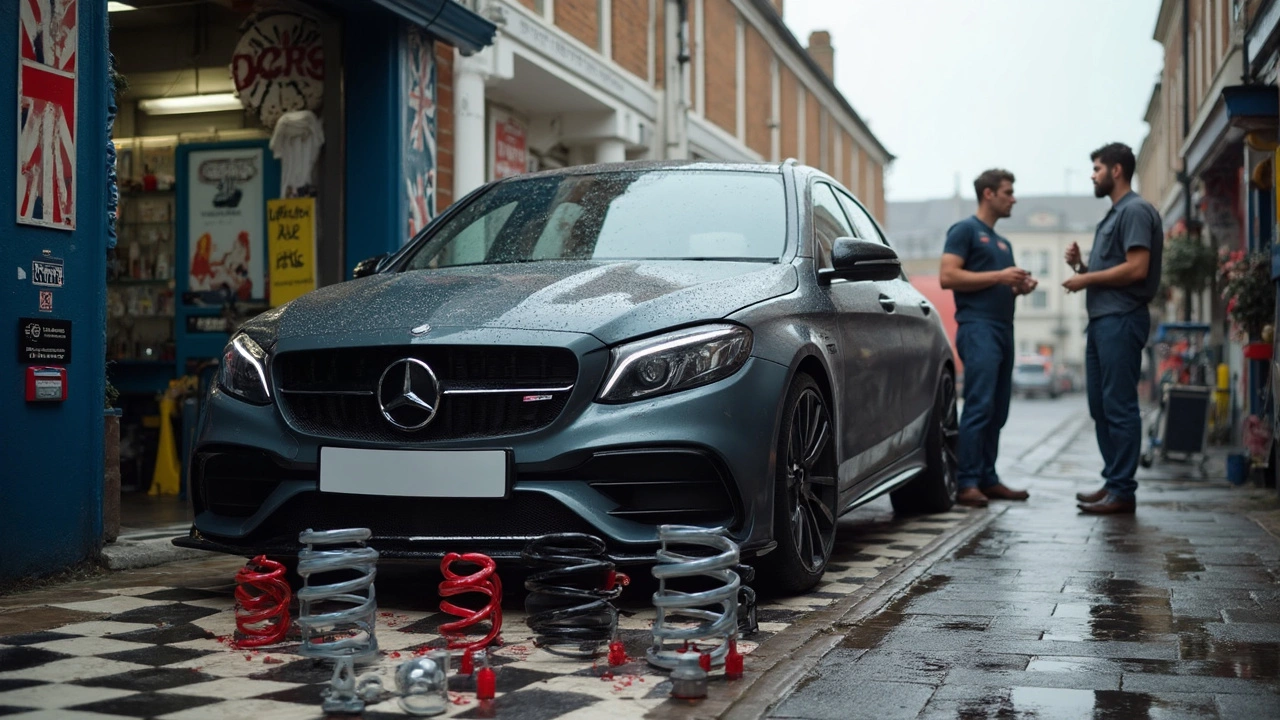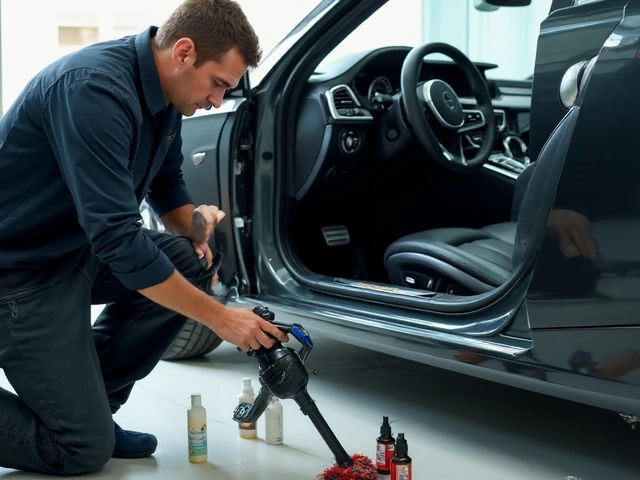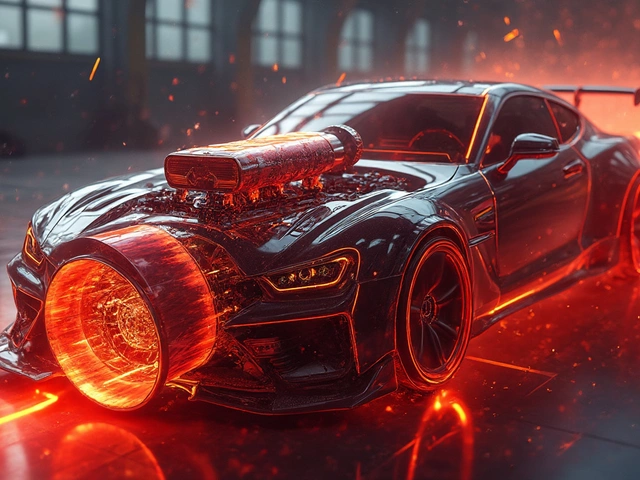If you’ve ever checked out a car slammed on lowering springs and got serious envy, you’ve probably wondered what you need to swap out besides the springs themselves. The big question is—can you just pop on lowering springs and call it done, or do your shocks need some attention too?
Lowering springs change your car’s ride height and how the suspension moves. Factory shocks are tuned for stock spring lengths and rates. Throw in shorter, stiffer springs, and things don’t always play nice. A lot of people try to cheap out and skip the shock upgrade when installing lowering springs, but that’s rolling the dice.
Here’s the deal: your shocks control the up-and-down motion of the springs. Put in lowering springs that are stiffer or shorter, and your stock shocks have to work harder—and often outside the range they were designed for. That can mess with ride comfort, but it can also wear out your shocks way faster than normal.
- How Lowering Springs Affect Your Suspension
- When Stock Shocks Just Don’t Cut It
- Ride Quality and Handling Changes
- Tips for a Trouble-Free Lowering Setup
How Lowering Springs Affect Your Suspension
When you throw on lowering springs, the biggest change you'll see right away is the drop in ride height. It usually means your car sits between 1 and 2 inches closer to the ground, which looks awesome. But it also changes how your suspension behaves on the road.
Here's the main deal: lowering springs are almost always stiffer than factory springs. This stiffer rate is needed to prevent your car from bottoming out, since there’s less travel between your tires and the body. That stiffness can make things feel sportier, but it also makes bumps a lot more noticeable compared to stock.
Your shocks, or struts, are designed to control the up-and-down movement for the springs you had from the factory. When you install lowering springs, you shorten the travel your shock was engineered for. So your stock shocks end up working overtime handling a stiffer, shorter spring.
Here’s why that matters:
- Your ride might feel harsher, especially on rough roads.
- Stock shocks often wear out way faster—sometimes in less than a year with aggressive driving.
- The car’s handling can get unpredictable if the dampers can’t keep up with the new setup.
According to Tire Rack’s experts:
"Lowering springs typically increase the spring rate to maintain vehicle control, which often exceeds what the original shocks were designed to handle."
Check out this quick comparison for a typical change after installing lowering springs on a compact sedan:
| Component | Stock Setup | After Lowering Springs |
|---|---|---|
| Ride Height | 6" ground clearance | 4.5" ground clearance |
| Spring Rate | 150 lbs/in | 210 lbs/in |
The lower ride and stiffer springs can definitely upgrade cornering. But they’ll also show you every crack and bump in the road, because the suspension just has less room to absorb it all. Combine all that, and you start to see why people talk about matching shocks when they go with lowering springs.
When Stock Shocks Just Don’t Cut It
So, you’ve got lowering springs in the mail, and you’re pumped for a drop. But here’s what car owners learn the hard way: factory shocks just aren’t built for the new setup. When you slam your car with lowering springs, the shocks might bottom out more on every bump, and that wrecks both your ride comfort and your suspension parts.
Stock shocks are designed for factory ride height and spring travel. Once you drop the car, the shocks don’t have as much room to move. That means you hit their travel limits more often, which can make your ride harsh fast. Over time, those shocks wear out early or, worse, start leaking. Not cool if you want a setup that lasts.
Also, lowering springs are almost always stiffer than stock. That’s great for less body roll and a sportier feel, but only if your shocks can keep up. OEM shocks just can’t control quicker spring rebound, so you get bouncy rides or that weird floating boat feeling at high speeds. Annoying, and kinda dangerous if you really push your car.
Here’s a quick breakdown of what often happens if you run lowering springs with factory shocks:
- Bounce and harshness over bumps become super noticeable
- Stock shocks wear out much sooner—sometimes within a few thousand miles
- Handling gets unpredictable at speed or in corners
- You might notice uneven tire wear from all that bouncing
If you’re unsure, check your car's manufacturer forums or talk to a mechanic who's done this swap. Most will tell you that upgrading to sport or performance shocks makes a world of difference for life span and ride quality. Plus, some aftermarket companies even bundle matched springs and shocks for this exact reason—it just works better together.
To get a quick sense of the difference, take a look at this:
| Stock Shocks + Stock Springs | Stock Shocks + Lowering Springs | Upgraded Shocks + Lowering Springs | |
|---|---|---|---|
| Ride Comfort | Good | Worse | Good |
| Shock Wear | Normal | High | Normal |
| Handling | Soft | Bouncy | Controlled |
End of the day, if you care about handling, ride quality, and long-lasting parts, matching your lowering springs to proper performance shocks isn’t just hype—it’s the real deal.

Ride Quality and Handling Changes
Install lowering springs, and you’re definitely going to feel a difference. Let’s be clear: they make your ride stiffer. Your car corners flatter and takes curves with more confidence. That’s because lowering springs usually have a higher spring rate, which means less body roll and a sportier feel behind the wheel.
But it’s not all good news. Swap springs and leave your old shocks? You open the door to some annoyances. Bumpy or uneven roads can feel way harsher since factory shocks aren’t tuned for the stiffer spring action. You might even hear extra rattles or notice the car bottoms out more easily on potholes or speed bumps.
Upgrading your shocks at the same time as your lowering springs tends to fix a lot of these issues. Performance shocks are built for the different compression and rebound caused by shorter, stiffer springs. They soak up bumps better and keep your tires planted when you’re pushing corners harder than stock.
Handling really does improve for most cars—especially front-wheel-drive models that love to understeer. A matched springs-and-shocks combo brings tighter steering response and better traction when you push it. Just keep in mind, a more aggressive setup sometimes means a sharper or rougher feel on rough pavement. Here’s a rough idea of what to expect with just springs vs. with new shocks too:
| Setup | Ride Comfort | Cornering | Shock Life |
|---|---|---|---|
| Lowering Springs Only | Noticeably Harsher | Improved | Shortened |
| Springs + Upgraded Shocks | Balanced/Controlled | Much Improved | Normal/Extended |
If you use cheap parts or skip the shocks, you sometimes get "bouncing" after hitting a dip—like riding a pogo stick. Not safe, and it gets old real quick. People serious about looks and handling almost always spring for both upgrades. It saves money and headaches down the road.
Tips for a Trouble-Free Lowering Setup
Dropping your car with lowering springs is more than just swapping out hardware. If you want things to actually work—and not rattle your teeth or blow out your shocks—there are a few tricks that make the whole process smoother.
First: use spring and shock combos designed to work together. Mixing random brands or picking parts because they’re cheap usually ends up being a pain. A matched set, like Bilstein B8 or Koni Sport shocks made for lowering springs, keeps things balanced and avoids weird noises or uneven tire wear.
- Check shock compatibility. Not all shocks are built for shorter travel. Standard OE shocks can bottom out with lowering springs, especially if you're going lower than an inch. Upgrading to short-body or "sport" shocks is a smart move if you want any durability.
- Get an alignment right after installing lowering springs. Lowering can mess with camber and toe, which chews up tires and hurts handling. Book that alignment before putting serious miles on your fresh setup.
- Watch your bump stops. Lowering gives you less room for suspension travel, so trim your bump stops by about 1/3 or use shorter aftermarket ones. Bottoming out isn’t just annoying—it can damage your new springs and shocks over time.
- Check for rubbing issues. Lowering means less wheel gap, so bigger wheels or wider tires might start to rub the fenders or liners. Test drive and listen for noises, then adjust as needed.
- Grease and torque everything. Squeaks and clunks are often caused by bolts that weren’t tightened or bushings that are dry. Clean up old hardware, use anti-seize or proper grease, and tighten everything to spec.
Here’s a quick look at what usually happens if you skip matched shocks with lowering springs:
| Component Setup | Typical Ride Quality | Shock Life |
|---|---|---|
| OEM Shocks + Stock Springs | Comfortable | Normal (80,000-100,000mi) |
| OEM Shocks + Lowering Springs | Harsh, Bouncy | Reduced (20,000-40,000mi) |
| Matched Sport Shocks + Lowering Springs | Sporty, Controlled | Normal (60,000-100,000mi) |
If you hate the idea of failing your next inspection or burning through two sets of tires in a year, don’t skimp on the details. Choose compatible parts, dial in the alignment, and don’t ignore anything that sounds off or feels weird after the install. Your wallet—and your spine—will thank you later.






